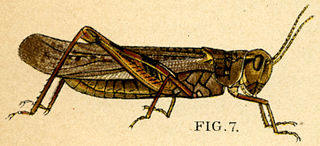Adaptation
How does it move?
Though M. differentialis has
fully functional, colorless wings its primary method of movement is
jumping. Highly specialized hind limbs allow grasshoppers to jump almost
a meter (Chapman
& Joern, 1990), which is roughly thirty times its body length!
That’s the equivalent of the average human jumping about half of a
football field!
Grasshoppers can walk, however their walking speed is very slow. Jumping
is an adaptation because it allows the grasshopper to move at otherwise
unattainable speeds to escape predation (Chapman
& Joern, 1990)
The incredible jumps of these grasshoppers are due to some amazing
adaptations of the hind legs. Grasshoppers are able to flex the muscles
in their hind legs without moving them. This enables it to attain much
higher stress levels in the muscle and thus more potential energy. By
releasing all this energy at once the grasshopper generates an explosive
catapult like force that launches it great distances relative to its
body length. (Chapman
& Joern, 1990)
Unfortunately for the grasshopper, because the hind legs are so
specialized for jumping they are rather clumsy when walking and
significantly slow down the insect. (Chapman
& Joern, 1990)
How does it react to environmental stimuli?
Antennae are one of grasshoppers’ most important tools, when analyzing
the world around them. The antennae allow the grasshopper to detect
moisture in food and in the environment. This adaptation is very
important because many of these grasshoppers inhabit very arid regions
like New Mexico and Arizona. In a 1985 experiment conducted by A.C.
Lewis and E.A. Bernays dehydrated insects (S.
gregaria) fed on fresh moisture rich leaves over their previous food
choice of dry leaves. The antennae were used to make the distinction
between fresh and dry leaves (Lewis, 1979).
The ability to detect moisture in the environment via the antennae is
another important adaptation, because it allows the grasshopper to be
more successful in the arid regions it often inhabits.
Though a study by (Bernays & Wrubel 1985) showed that some species of
grasshoppers could see in color and associate color with food it was
later determined that none of the experiments on attraction by vision
suggested a significant degree of specificity to host plants.
Though it is still uncertain how grasshoppers locate their food over
long distances it is understood that an insect already on or near a
plant perceives it through chemical receptors in the antenna (Chapman
& Joern, 1990). The ability to detect and distinguish food
sources in the environment is another important adaptation of the
antenna. This particular trait allows the grasshopper to more
efficiently navigate and utilize its environment, which is very
important since it is so small and has relatively less effective
eyesight.
The structure of the antenna is very important with regards to its
function. The antennae are external protrusions from the head. The
externality of these appendages allow for direct contact with the
environment and can thus detect air born chemicals or interpret
something as food without direct ingestion.



